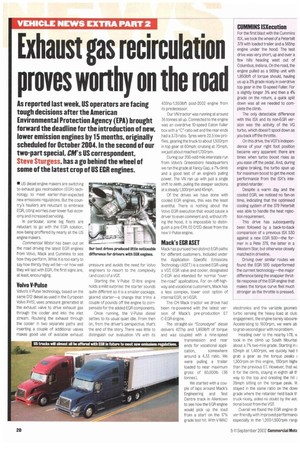Exhaust gas recirculation proves worthy on the road
Page 20

If you've noticed an error in this article please click here to report it so we can fix it.
As reported last week, US operators are facing tough decisions after the American Environmental Protection Agency (EPA) brought forward the deadline for the introduction of new, lower emission engines by 15 months, originally scheduled for October 2004. In the second of our two-part special, CM's US correspondent. Steve Sturgess, has a go behind the wheel of some of the latest crop of US EGR engines.
• US diesel engine makers are switching to exhaust gas recirculation (EGR) technology to meet earlier-than-expected new emissions regulations. But the country's hauliers are reluctant to embrace EGR, citing worries over lower fuel economy and increased servicing.
In particular, some big fleets are reluctant to go with the EGR solution, now being proffered by nearly all the US engine makers.
Commercial Motor has been out on the road driving the latest EGR engines from Volvo, Mack and Cummins to see how they perform. While it is too early to say how thirsty they will be—or how well they wit last with EGR, the first signs are, at least, encouraging.
Volvo V-Pulse
Volvo's V-Pulse technology, based on the same D12 diesel as used in the European Volvo FH12, uses pressure generated at the exhaust valve to drive exhaust gas through the cooler and into the inlet stream. Routeing the exhaust through the cooler In two separate paths and inserting a couple of additional valves makes good use of available exhaust pressure and avoids the need for Volvo engineers to resort to the complexity (and cost) of a VGT.
Starting the V-Pulse 12-litre engine holds a mild surprise: the starter sounds quite different as it is a smaller-package, geared starter—a change that trims a couple of pounds off the engine to compensate for the added EGR components.
Once running, the V-Pulse diesel settles to its usual quiet idle. From then on, from the driver's perspective, that's the end of the story. There was little to distinguish our evaluation VN with its 435hp/1,550Ibft post-2002 engine from its predecessor.
Our VN tractor was running at around 36 tonnes all up. Connected to the engine was an overdrive 10-speed Eaton Fuller box with a "C" ratio set and the rear ends had a 313 ratio. Tyres were 22.5 low profiles, gearing the truck to about 1,500rpm in top gear at 60mph: cruising at 70mph, we just about reached 1,700rpm.
During our 200-odd mile interstate run from Volvo's Greensboro headquarters we ran the grade at Fancy Gap, a 7% climb and a good test of an engine's pulling power. The VN ran up with just a single shift to ninth, puling the steeper sections at a steady 1,300rpm and 45mph.
Of the drives we have done with cooled EGR engines, this was the least eventful. There is nothing about the Volvo EGR execution that would cause a driver to even comment and, without lifting the hood, it is impossible to distinguish a pre-EPA 02 D12D diesel from the new V-Pulse engine.
Mack's El ASET
Mack has pursued two distinct EGR paths for different customers. Included under the Application Specific Emissions Technology (ASET) is a cooled EGR using a VGT, EGR valve and cooler, designated C-EGR and intended for normal "overthe-road" applications. For on-/off-highway and vocational customers, Mack has a less complex, lower cost option of internal EGR, or I-EGR.
The CH Mack tractor we drove had been re-powered with the latest version of Mack's pre-production E7 C-EGR engine.
The straight-six "Econodyne" diesel delivers 427hp and 1,460Ibft of torque and was coupled with a nine-speed transmission and rear ends for vocational appli cation, somewhere around a 4.33 ratio. We were pulling a trailer loaded to near maximum gross of 80,000lb (36 tonnes).
We started with a couple of laps around Mack's Engineering and Test Centre track in Allentown to see how the EGR engine would pick up the load from a start on the 17% grade test hill, With V-MAC electronics and the variable geometr turbo sensing the heavy load at dutc engagement, the engine barely labourei Accelerating to 1800rpm, we were ab to grab second gear with no problem.
Heading over to the nearby 1-78, vi took in the climb up South Mountaii about a 7% two-mile grade. Starting in ; 52mph at 1,400rpm, we quickly had 1 grab a gear as the torque peaks ; 1,300rpm on this engine, 100rpm high( than the previous E7. However, that wE it for the climb, staying in eighth all tr way to the top and cresting the hill i 35mph sitting on the torque peak. Vs stayed in the same ratio on the dowi grade where the retarder held back th truck nicely, aided no doubt by the adc tional boost from the VGT.
Overall we found the EGR engine dr ver-friendly with improved performanci especially in the 1,200-1,500rpm rang




























































































































































